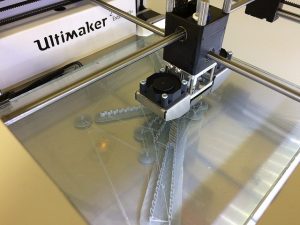
When researching the different forms of 3D printing, you’ll probably come across selective laser sintering. A form of additive manufacturing, it uses a laser to “sinter” powder particles. In other words, the material used in laser sintering is fused together with the help of a laser. While laser sintering may sound highly technical, it’s actually a simple form of additive manufacturing that relies on just a few basic steps.
The Basics of Laser Sintering
Developed by University of Texas (UT) researchers in the 1980s, laser sintering is one of the oldest forms of additive manufacturing. It’s designed to build three-dimensional objects by “selectively sintering” powder particles with a laser.
During laser sintering, a laser — typically a carbon dioxide laser — moves across a bed of powder while exposing specific areas of the powder to the laser light. Exposure to the laser, of course, causes the powder particles to fuse together.
Some of the most common types of powder used in laser sintering include the following:
- Plastic
- Ceramics
- Glass
- Metals
- Alloys
Selective Laser Sintering vs Melting: What’s the Difference?
Many people assume that selective laser sintering is the same as selective laser melting, but this isn’t the case. When a material is sintered, it’s exposed to just enough heat to induce fusion. When a material is melted, on the other hand, it’s exposed to greater heat, thereby changing the material’s physical properties.
Selective laser melting can also be used to create three-dimensional objects, but it’s not as popular as selective laser sintering. Sintering doesn’t actually melt the powder particles used as the base material. Rather, it only exposes them to enough heat to induce fusion. Selective laser melting, as you may have guessed, does in fact melt the powder particles.
The Science Behind Laser Sintering
Laser sintering requires the use of a specialized sintering-based 3D printer as well as powder. With that said, the 3D printer uses in laser sintering doesn’t need an external feeder. The substrate is encased in powder particles throughout the entire process, so an external feeder isn’t necessary.
During laser sintering, the 3D printer’s laser will simply move across the powder particles while selectively exposing them to laser light. The laser light won’t melt the powder particles. It will, however, induce fusion so that they bind together. Fusion forces the powder particles to harden and solidity. Once finished, the printed object can be removed from the remaining bed of unsintered powder particles.
No tags for this post.